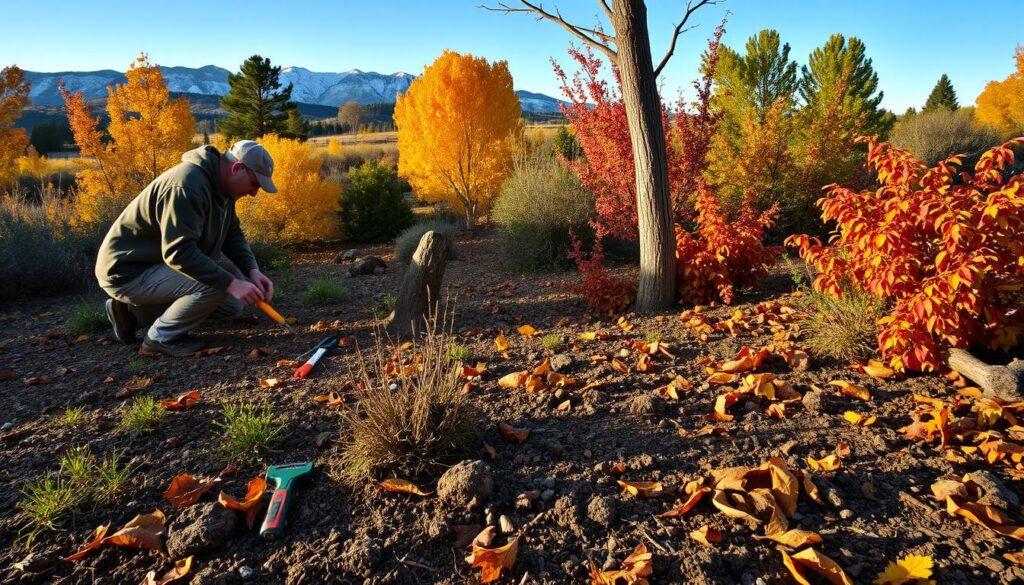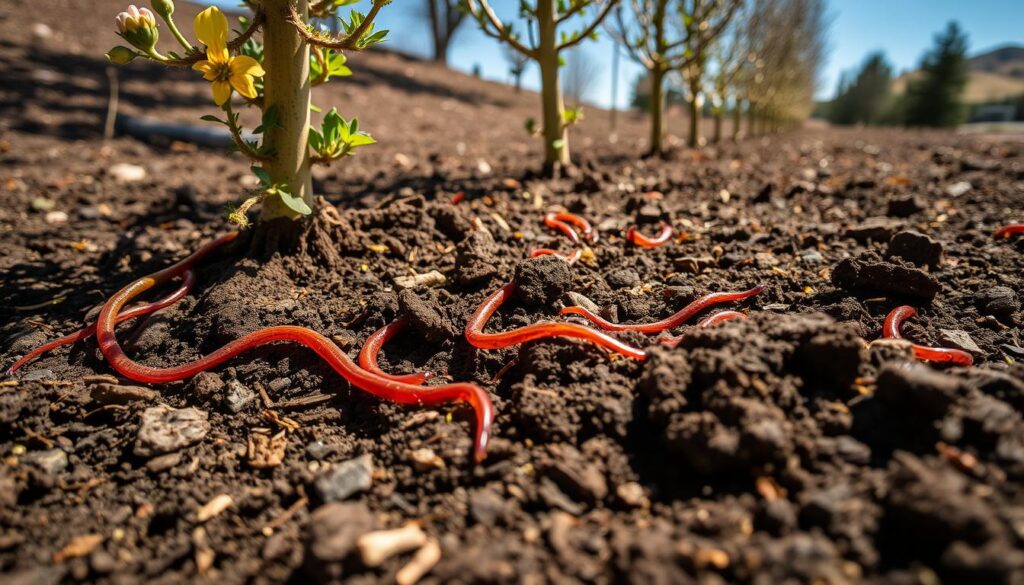
Winter tree care in Prescott, Arizona, is a big challenge. The area’s climate and soil need special care to keep trees healthy. Improving soil quality is vital for frost protection and tree health.
For those gardening in Prescott AZ, soil quality is very important. It affects how well trees can handle cold winters. By improving the soil, you can make your trees stronger and their roots healthier. This guide will show you how to care for your trees during winter, starting with soil assessment.
Checking your soil is the first step in getting your trees ready for winter. Look at pH levels, nutrients, and soil structure. This helps you make the right changes. Good soil management means your trees can handle Prescott’s winters better.
Key Takeaways
- Soil quality is crucial for winter tree protection in Prescott, AZ
- Regular soil assessment helps identify improvement needs
- Proper soil management enhances tree resilience to frost
- Tailored soil improvement techniques boost overall tree health
- Understanding local soil conditions is key to effective winter tree care

Understanding Prescott’s Unique Soil Characteristics
Prescott’s soil is as varied as its landscape. The area has different soil types that affect gardening in Northern Arizona. Each type, from sandy loams to clay-rich earth, brings its own set of challenges and opportunities for plants.
Local Soil Types and Composition
- Sandy loams in higher elevations
- Clay-rich soils in valley bottoms
- Rocky soils on hillsides
This variety impacts how well water and nutrients are held, and how roots grow.
Climate Impact on Soil Conditions
The climate in Prescott has a big impact on the soil. Hot summers and cold winters cause the soil to expand and contract. This can lead to:
- Soil compaction
- Erosion
- Changes in soil pH
These factors are key to plant health and growth.
Natural Soil Challenges in Northern Arizona
Gardening in Northern Arizona comes with its own set of soil challenges. The area’s alkaline soils can make it hard for some plants to get the nutrients they need. Low organic matter also makes it tough for roots to grow. Gardeners often have to add amendments to the soil to help plants thrive.
In Prescott, Arizona, the soil composition changes a lot. You’ll find:

Winter Tree Soil Quality Improvement Techniques
Improving soil quality is crucial for winter tree care. Good soil helps trees fight off harsh conditions and grow well. Let’s look at ways to make your soil better for your trees.
Essential Soil Nutrients for Winter Hardiness
Trees need certain nutrients to get ready for winter. Potassium helps them fight colds and diseases. Phosphorus makes roots strong. Nitrogen keeps the tree healthy. A soil test can show what your soil is missing.
pH Balance Optimization Methods
Soil pH is important for nutrient use. Most trees like slightly acidic soil, with a pH of 6.0 to 7.0. To lower the pH, add sulfur. To raise it, use lime. Add these slowly to avoid shocking the roots.
Organic Matter Integration Strategies
Organic matter makes the soil better and more fertile. It keeps moisture and nutrients in. Add compost, leaf mold, or well-rotted manure to your soil. Mix it gently into the top few inches around your trees.
- Use a soil testing kit to guide your improvement efforts
- Apply organic mulch to protect the soil and add nutrients slowly
- Water deeply but infrequently to encourage deep-root growth
These soil improvement techniques will make your trees stronger for winter. Remember, healthy soil means resilient trees that can handle the cold months well. Give yourself the gift of knowledge – read this remarkable piece.
Soil Testing and Assessment Methods
Knowing your soil’s condition is key for protecting trees in Prescott during winter. Soil testing kits are a quick way to check your soil’s health. They measure pH levels, nutrient content, and soil structure.
DIY soil assessment is a good starting point. Simple tests like the jar test can show soil composition. Fill a jar with soil and water, shake it, and let it settle. The layers that form show the proportions of sand, silt, and clay in your soil.
For a deeper analysis, consider professional soil testing. Local extension offices often offer this service. They provide detailed reports on your soil’s nutrient levels, pH, and organic matter content.
Regular soil testing helps track changes over time. It’s best to test your soil every 3-5 years. This ensures you’re always aware of your soil’s needs and can adjust your care routine accordingly.
- Use soil testing kits for quick checks
- Try simple DIY soil assessment techniques
- Seek professional soil testing for detailed analysis
- Test soil regularly to monitor changes
By understanding your soil through these methods, you can make informed decisions about soil improvements. This knowledge is crucial for keeping your trees healthy through Prescott’s challenging winters.

Protective Mulching Strategies for Winter Soil Health
Winter mulching is crucial for soil protection and tree root care. It keeps the soil safe from harsh winter weather. This helps maintain a stable environment for tree roots.
Proper Mulching Materials Selection
Organic mulch is the best choice for winter soil health. Wood chips, straw, and leaf litter are great options. They insulate the soil, keep moisture in, and slowly break down to make the soil richer.
Application Timing and Techniques
Spread mulch in late fall, after the ground freezes. This stops early freezing and thawing. Put it around the tree, covering the drip line. Make sure it’s a few inches from the trunk to avoid damaging the bark.
Mulch Depth Guidelines
Keep the mulch layer between 2 to 4 inches for best soil protection. This depth is enough to insulate without choking the roots. Adjust the thickness based on your local climate and soil type.
- Coarse mulch: Apply up to 4 inches
- Fine mulch: Limit to 2 inches
- Sandy soils: Use thicker layers
- Clay soils: Apply thinner layers
By using these winter mulching strategies, you’ll protect your trees. This ensures healthy roots and strong growth in the spring.
Soil Amendment Solutions for Desert Winter Conditions
Desert winters in Prescott, Arizona, need special care for your trees. Soil amendments are key to protecting and nourishing them during the cold months. Let’s look at some effective strategies for desert gardening and winter soil care.
Organic Amendments for Better Retention
Improving your soil with organic matter is vital for winter tree health. Use compost, aged manure, or leaf mold to help retain water. These materials keep sandy desert soils moist longer, keeping roots hydrated in dry times.
Mix in 2-3 inches of organic matter into the top 6-8 inches of soil around your trees.
Mineral Supplements for Soil Structure
Mineral supplements improve soil structure in desert areas. Gypsum and lime help clay soils, while rock dust adds trace elements. These supplements create a better-growing space for your trees, helping them grow stronger roots that can handle winter stress.
Timing of Amendment Applications
Apply soil amendments in early fall. This lets roots absorb nutrients and adapt to better soil before winter. Remember, the right timing is key for effective winter soil care in desert regions.
Yavapai Landscaping Prescott offers complimentary estimates for Prescott and its surrounding communities for Landscaping and tree Services. This includes tree removal, trimming, stump grinding, land clearing, storm clean-up, and emergency tree services.
